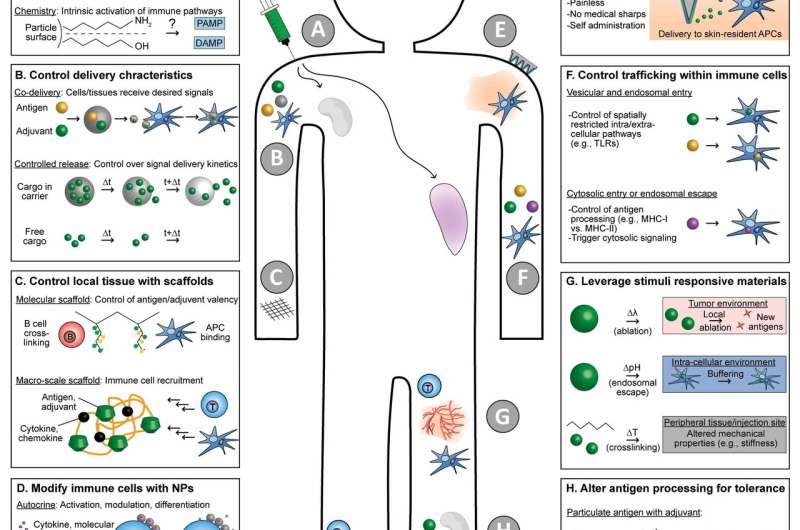Bioengineers imagine the future of vaccines and immunotherapy

In the not-too-distant future, nanoparticles delivered to a cancer patient's immune cells might teach the cells to destroy tumors. A flu vaccine might look and feel like applying a small, round Band-Aid to your skin.
These are examples of how innovative biomaterials could enhance vaccines against HIV and other infectious diseases and immunotherapies for patients with cancer or dampen responses in autoimmune disorders, allergies and transplanted organ recipients. A review of these efforts appears December 14 in the journal Trends in Immunology.
Bioengineer Christopher Jewell and transplant surgeon and immunologist Jonathan Bromberg, both at the University of Maryland, teamed up to highlight the potential uses of proteins, lipids and polymer particles as new and improved delivery carriers in vaccines and immunotherapies.
"This is a brand-new way of thinking about how, where and when to deliver immune signals and antigens so you get a much better immune response," says Bromberg, professor of surgery and microbiology and immunology at the University of Maryland's medical school and co-senior author. "It's allowing some real paradigm shifts in thinking about vaccines for treating and preventing infectious disease, and also for potential vaccines for cancer."
In cancer, strategies include modifying specialized immune cells—T cells—with nanoparticles that provide a blueprint for destroying cancerous cells. In autoimmune diseases such as multiple sclerosis, researchers are exploring ways to use polymer particles carrying specific combinations of immune signals to deactivate malfunctioning immune cells that attack healthy cells.
Jewell, associate professor in the Fischell Department of Bioengineering and co-senior author, notes that many of these ideas are still in the pre-clinical stage and will need to be weighed against existing technologies. Microneedle patches for flu vaccinations, for one, recently proved safe and effective in a human clinical trial; many who tried it preferred it to a traditional flu shot.
The patch, embedded with almost invisible needles, delivers the vaccine to immune cells just under the skin's surface with no pain, medical visits or syringes. Patches don't require refrigeration, potentially expanding the reach and safety of vaccines in developing countries. Patches also reduce the medical waste generated by syringes. And you can apply them at home.
Vaccines are usually a mixture of two critical components: the antigen, which allows the specific recognition of a microbe, and adjuvants, which activate immune cells. Biomaterials may soon deliver adjuvants that boost and lengthen vaccines' effectiveness while minimizing the amount of injected foreign material in the body. Controlled loading and release from degradable scaffolds might help eliminate the need for multiple vaccinations.
A transplant immunologist, Bromberg seeks new ways to prevent organ rejection. He's intrigued by the possibility of immunosuppressive vaccines that inhibit the immune response. Immunomodulators that modify or weaken the immune system can also reduce inflammation caused by allergies and/or autoimmune disorders in which the body's immune system attacks its own cells.
Certain biomaterials even appear to directly activate immune pathways on their own and effectively serve as both the carrier and the adjuvant. This could lead to next-generation materials that actively control the body's responses to antigens or immunotherapy.
"Now we have an opportunity to have the carrier manipulate the immune system based on the structure, providing an additional route to engineer the most effective immune response," Jewell says.
More information: Michelle L. Bookstaver et al, Improving Vaccine and Immunotherapy Design Using Biomaterials, Trends in Immunology (2017). DOI: 10.1016/j.it.2017.10.002

















